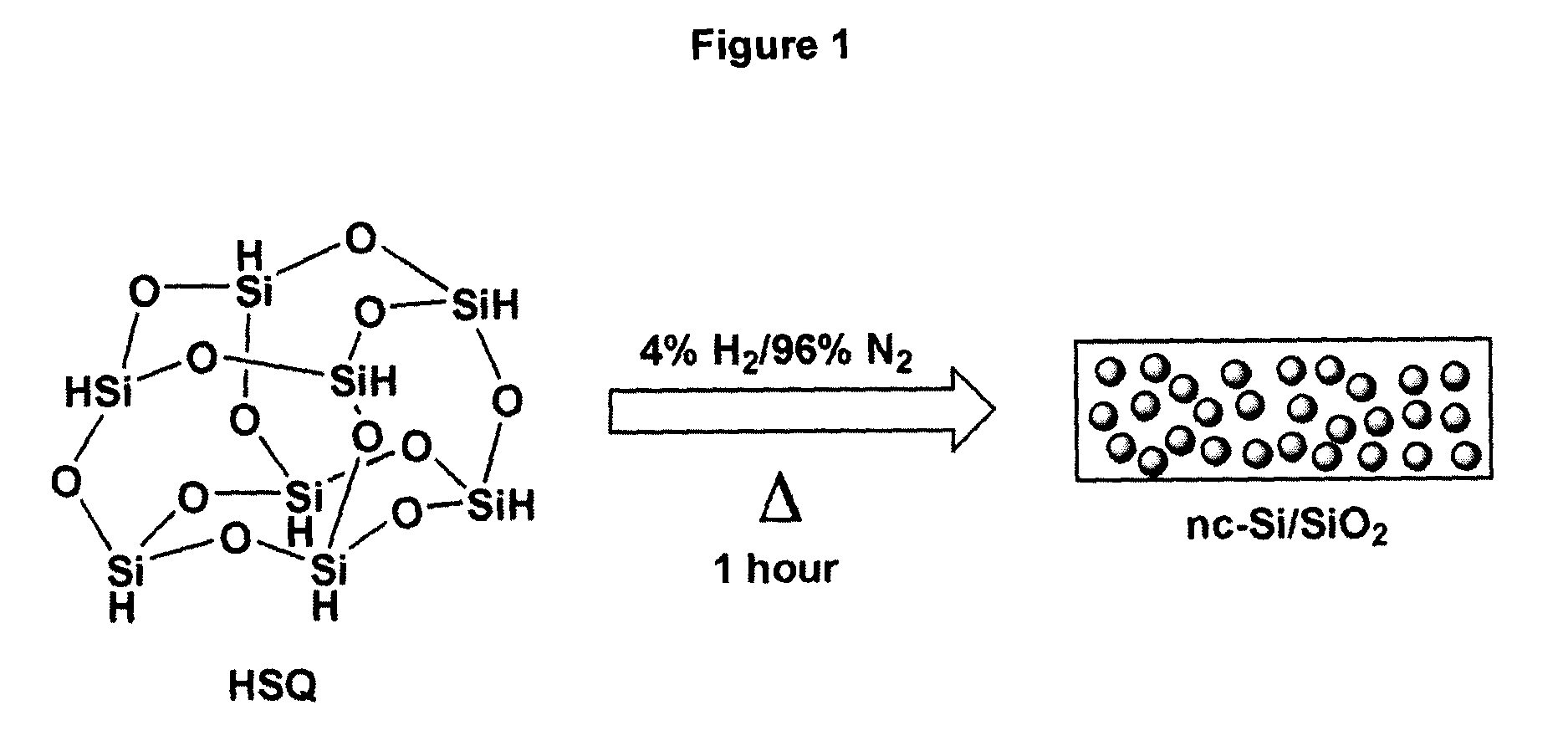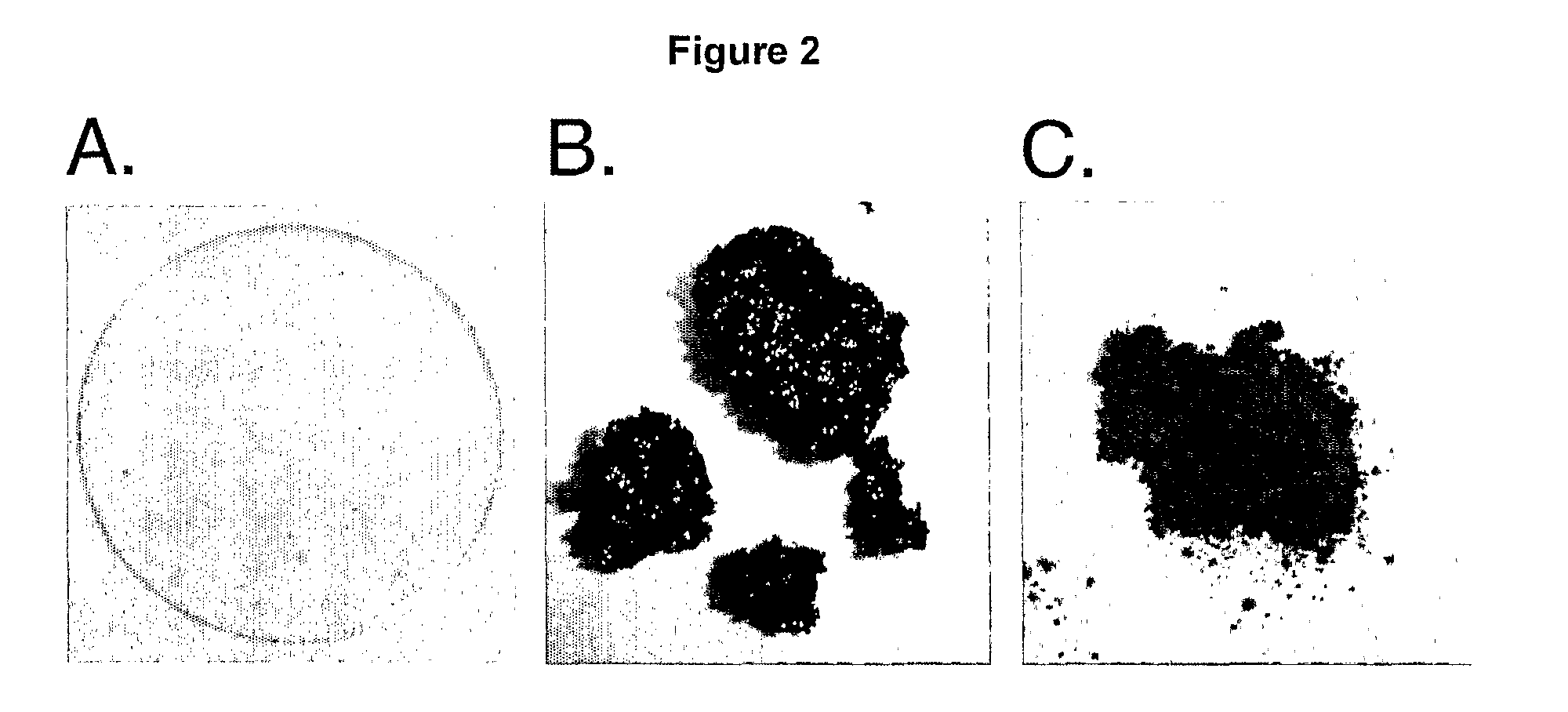Method for preparing nanocrystalline silicon in sio2 and freestanding silicon nanoparticles
- Summary
- Abstract
- Description
- Claims
- Application Information
AI Technical Summary
Benefits of technology
Problems solved by technology
Method used
Image
Examples
example 1
Thin film and Bulk nc-Si / SiO2 Composite Preparation
[0055]Hydrogen silsesquioxane was spincoated from a commercially available FOx-12® as a conformal, clear, colourless film that, upon reductive thermal processing in a 4% H2:96%N2 atmosphere, maintains its transparency, appears faint orange, is adherent (Scotch tape test) and resistant to abrasion (FIG. 1, FIG. 2). Reductive annealing of bulk quantities of white, crystalline HSQ using the aforementioned conditions for thin film thermal processing yields dark amber, glassy products that upon mechanical grinding yield orange / brown powders in near quantitative yield (FIG. 2B,C). TEM, SAED, XRD, and photoluminescence spectroscopy confirm thermal processing of thin film and bulk HSQ samples yield luminescent, diamond lattice, elemental silicon nanocrystallites encapsulated in a SiO2-like matrix (vide infra). Embedded Si nanoparticles are readily liberated upon exposure of the nanocomposite to hydrofluoric acid which preferentially etches ...
example 2
Thermal Gravimetric Analysis
[0056]Thermal processing of neat HSQ samples was evaluated using thermal gravimetric analysis (TGA). In a nitrogen atmosphere, thermal traces of HSQ obtained at a heating rate of 10° C. / min show four distinct regions of weight loss (ca. 50-225° C.; 1.8%, 225-375° C. ; 2.1%, ca. 375-425° C.; 0.8%, ca. 507° C.; 43%). With increased heating rate (i.e., 10, 20, 50, 100° C. / min) a dramatic decrease (FIG. 4) in the observed weight loss at 507° C. (i.e., 10° C. / min, 43% vs. 100° C. / min, 5%) was noted. TGA analysis of HSQ in 4%H2:96%N2 shows ca. 5% weight loss regardless of heating rate.
[0057]The accepted stages of HSQ thermal processing in inert atmosphere (i.e., N2 or Ar) are summarized in FIG. 5 and have previously been attributed to: i) trace solvent loss (4 (ca. 250-350° C.), iii) Si—H thermal dissociation accompanied by loss of SiH4 and H2 (350-450° C.), and iv) collapse of the pore structure (>450° C.). Detailed literature studies of HSQ thermal properties...
example 3
FT-IR Spectroscopy
[0058]FT-IR spectroscopy of NEAT HSQ shows a characteristic absorption at 2251 cm−1 that is readily assigned to Si—H stretching (FIG. 6A). Absorptions are also noted in the range ca. 1300 to 800 cm−1 and have previously been assigned to internal vibrations of the Si—O—Si cage framework.59 Following reductive annealing (FIG. 6B) the absorption assigned to Si—H stretching disappears suggesting the HSQ molecules are crosslinked and the cage structure has collapsed. The replacement of broad HSQ Si—O—Si vibrations with a broad featureless absorption centered at ca. 1096 cm−1, that was assigned to Si—O—Si bending in an SiO2-like network, was also observed. FIG. 6C shows a typical FT-IR spectrum of partially etched nc-Si / SiO2 powder following etching in 1:1:1 49% HF:H2O: ethanol for 120 minutes. Characteristic Si—H, stretching at 2100 cm−1 confirms particle hydride termination. In addition, a marked decrease in intensity of absorptions attributed to Si—O—Si vibrations at≦...
PUM
 Login to View More
Login to View More Abstract
Description
Claims
Application Information
 Login to View More
Login to View More - R&D
- Intellectual Property
- Life Sciences
- Materials
- Tech Scout
- Unparalleled Data Quality
- Higher Quality Content
- 60% Fewer Hallucinations
Browse by: Latest US Patents, China's latest patents, Technical Efficacy Thesaurus, Application Domain, Technology Topic, Popular Technical Reports.
© 2025 PatSnap. All rights reserved.Legal|Privacy policy|Modern Slavery Act Transparency Statement|Sitemap|About US| Contact US: help@patsnap.com



